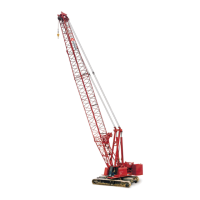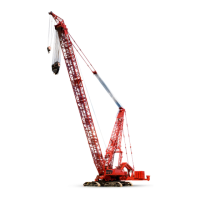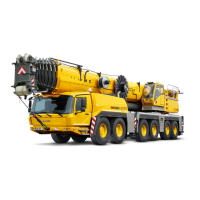POWER TRAIN 777 SERVICE MANUAL
7-8 Published 10-01-2012, Control # 045-08
18. Set A/B switches to RUN MODE position — A switch ON
and B switch ON.
19. Test hand and foot throttles for proper full throttle
operation, as follows:
a. With hand throttle pulled back fully (foot throttle up
fully), engine speed must be as close to 2,100 rpm
as possible without going under.
b. With foot throttle pressed down fully (hand throttle
forward fully), engine speed must be as close to
2,100 rpm as possible without going under.
c. Repeat steps 13 – 18b until speed in RUN 2 position
matches speed in RUN MODE as closely to 2,100
rpm as possible without going under.
d. If proper speed cannot be obtained, check foot
throttle linkage adjustment.
ENGINE THROTTLE ADJUSTMENT -
CUMMINS 6CTA8.3-C260 ENGINE
The throttle assembly for the Cummins 6CTA8.3-C260
engine consists of a hand throttle in the left control console, a
foot pedal on the cab floor, two controllers with
potentiometers, associated linkage, and electrical
connections.
Foot Throttle Linkage Adjustment
See Figure 7-4 for following procedure.
1. Install spring clip (1) and rod end (2) on controller lever
at dimension shown in View A and securely tighten jam
nut (3).
2. Insert a 3/16 in. (5 mm) thick shim or piece of floor mat
between foot pedal and cab floor.
3. Press foot pedal down fully to HIGH IDLE position
against shim or floor mat.
4. Adjust reach rod (4) and rod end (5) so controller lever is
rotated fully to HIGH IDLE position. Securely tighten jam
nuts (6) to lock adjustment.
NOTE: Controllers have internal stops at high and low idle.
5. Release foot pedal to low idle position.
6. Adjust return springs so there is sufficient force to raise
pedal and rotate controller lever to low idle.
7. Adjust pedal stop screw (7). Screw must be tight against
cab floor and there must be 1/8 in. (31 mm) gap between
pin (9) and rear end of slot in rod end (5). Securely
tighten jam nut (8).
8. With foot pedal in LOW IDLE position, distance from top
of pedal to cab floor should be 3-15/16 in. (100 mm).
Electronic Speed Control Adjustment
See Figure 7-6 for following procedure.
The electronic speed control was adjusted at the factory and
should not need further attention. Adjustment is required if
the control is replaced. Adjustments are to be completed in
the sequence given in this topic.
The electronic fuel control is located in the junction box
mounted on the right side of the engine. Figure 7-6 shows
the locations of the potentiometers and other controls inside
the junction box.
Engine speeds given in this topic are nominal, and can vary
plus or minus 50 rpm.
Setting High Speed
1. In cab, make sure clutch is engaged.
2. Start engine.
3. Set throttle to high speed setting.
4. Turn speed pot until ENGINE SPEED on digital display
shows speed is 2,200 rpm.
Low idle is determined by the value of the resistors in the
circuit. Low idle should be approximately 1,000 rpm.
Setting Gain and Stability
1. Set throttle to high speed setting (2,200 rpm).
2. Adjust GAIN as follows:
a. Slowly turn gain adjusting screw clockwise until
engine becomes unstable (engine operation
becomes erratic).
b. Slowly turn gain adjusting screw counterclockwise
until engine becomes stable.
c. Turn gain adjusting screw one division further
counterclockwise to ensure stable performance.
3. Adjust STABILITY as follows:
a. Slowly turn stability adjusting screw clockwise until
engine becomes unstable (engine operation
becomes erratic).
b. Slowly turn stability adjusting screw counter-
clockwise until engine becomes stable.
c. Turn stability adjusting screw one division further
counterclockwise to ensure stable performance.
4. Test hand and foot throttles to make sure they both
operate within high and low idle settings.
NOTE: Adjustments made at no load achieve satisfactory
performance. Gain and stability may require minor
adjustments after engine load is applied.

